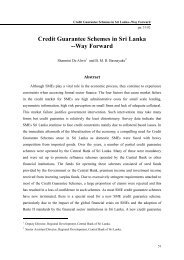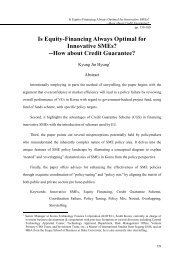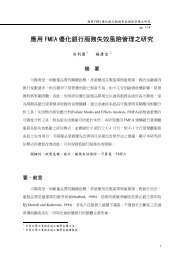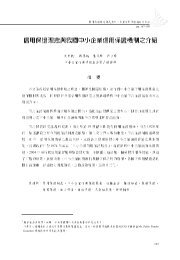Korea Credit Guarantee Fund and Its Contribution to the Korean Economy
Korea Credit Guarantee Fund and Its Contribution to the Korean ...
Korea Credit Guarantee Fund and Its Contribution to the Korean ...
You also want an ePaper? Increase the reach of your titles
YUMPU automatically turns print PDFs into web optimized ePapers that Google loves.
optimal SME support policy, professional workforce <strong>and</strong> ethical operation. Through continuousinnovation efforts, KODIT aims <strong>to</strong> remain as <strong>the</strong> trustworthy partner of SMEs <strong>and</strong> contribute <strong>to</strong>fur<strong>the</strong>r economic growth of <strong>Korea</strong>.Key words : <strong>Credit</strong> guarantee system, Small <strong>and</strong> medium enterprises (SMEs), <strong>Korea</strong> <strong>Credit</strong><strong>Guarantee</strong> <strong>Fund</strong>, KODITI. Introduction<strong>Credit</strong> guarantee scheme is widely used in various countries, both in underdeveloped <strong>and</strong>developed countries. It is reported that over 2,250 schemes exist in various forms in almost 100countries (Green, 2003). <strong>Credit</strong> guarantee also boasts of a long his<strong>to</strong>ry, which dates back <strong>to</strong> 3B.C., as it was written in <strong>the</strong> ancient Mesopotamia clay tablets (KODIT, 1998). Today <strong>the</strong> creditguarantee system of each country comes in different shapes, reflecting <strong>the</strong> his<strong>to</strong>ry <strong>and</strong> <strong>the</strong> socioeconomicdevelopment stage of <strong>the</strong> country. Even countries in a similar stage of economicdevelopment or in geographical proximity may be operating different type of systems. Thus, itis hard <strong>to</strong> draw a definition of credit guarantee that exists in a wide variety of forms. Yet, it iswidely accepted that credit guarantee system attempts <strong>to</strong> overcome <strong>the</strong> credit marketimperfection which disadvantaged groups—notably <strong>the</strong> small <strong>and</strong> medium enterprises(SMEs)—are experiencing in getting formal loans, by allowing lenders <strong>to</strong> shift loan recoveryrisks <strong>to</strong> <strong>the</strong> guarantee program (Vogel & Adams,1997). It is generally said that <strong>the</strong> creditlimitation of SMEs stems from high administrative costs of small-scale lending 1 , asymmetricinformation, <strong>the</strong> high risk attributed <strong>to</strong> SMEs <strong>and</strong> <strong>the</strong>ir deficiency in collateral 2 . Such lack ofcredit restricts <strong>the</strong> growth of SMEs <strong>and</strong> causes regionally-unbalanced growth, waste ofentrepreneurial resources, under-investment, which ultimately hinders <strong>the</strong> economic vigor <strong>and</strong><strong>the</strong> long-term development of <strong>the</strong> national economy.Many nations have made various efforts <strong>to</strong> alleviate <strong>the</strong>se problems caused by SMEslimited access <strong>to</strong> credit, one of <strong>the</strong>m being <strong>the</strong> credit guarantee system. The <strong>Korea</strong>n governmentfounded <strong>Korea</strong> <strong>Credit</strong> <strong>Guarantee</strong> <strong>Fund</strong> (KODIT) 3 in June 1976 in order <strong>to</strong> tackle this problem.1 Generally, <strong>the</strong> administrative cost of ten USD 10,000 loans is higher than that of one USD 100,000 loan.2 Green Anke, op. cit.3 Upon its 30 th anniversary, <strong>Korea</strong> <strong>Credit</strong> <strong>Guarantee</strong> <strong>Fund</strong> changed its acronym <strong>to</strong> KODIT, which comes from <strong>Korea</strong><strong>and</strong><strong>Credit</strong>.98
















